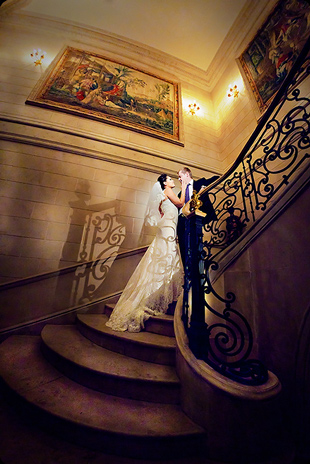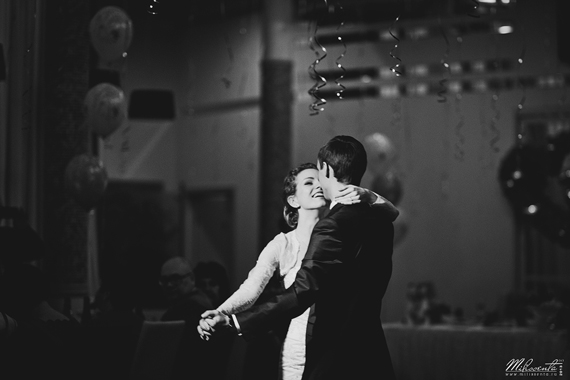Weddings, by their nature, have beautiful background scenery. This scenery is carefully planned and set up hours before the big day. For these reasons, you want to include it in your photos–that is, not just have the subject of the photos lit up by your flash, but everything behind in shadows, too. This is referred to as the miner’s light.

“Untitled” captured by PictureSocial member Grigoryev Sergey
You also don’t want to be just shooting with extremely high ISOs for the whole wedding with no flash. This is a good technique for certain photos, but many times this makes the pictures appear as if they were cropped from bigger pictures. Another reason you don’t want to use this technique for all of your photos is that sometimes there is fast action that you need to catch, and you probably don’t want the subject’s face out of focus.
So how do you shoot in low light situations, have the backgrounds visible, and have your subjects properly exposed, but include no harsh shadows and stay in sharp focus? The answer is bouncing your flash.
To properly expose the couple and not have your flash producing harsh shadows on their faces, you need a bigger light source. Remember, the bigger the light source, the softer the shadows. That’s why, when you use an umbrella, the shadows are so nice and soft. The umbrella is the source of light, and it is a lot bigger than your flash. This is the way it is, and there is no way around it.
Those little cups that you put over your flash don’t make the shadows softer; they only even out the light so that there aren’t any hot spots. Other light modifiers you see do increase the size of your light source. Examples of these may be the big Tupperware-looking things you see, or else a large bounce card.
But wouldn’t the shadows be even softer with a bigger light source? How about one the size of a wall or ceiling? This is what bouncing your flash is: turning the head of your flash so that the light first bounces off a wall, ceiling, etc., before hitting your subjects. This increases the size of your light source.
I like to bounce my flash off corners, if possible. The corners where the walls meet the ceiling produce some very nice results. If you have an assistant, make sure they are bouncing the light for you. Now you just have to worry about your camera communicating with your assistant’s lights. If you’re going wireless, or you are connected through a cable, no problem. If you’re going through Nikon’s or Canon’s incorporated system, you just need to make sure your flashes can see each other.
When bouncing your flash to work in low light situations, I recommend you have your ISO bumped up to 1600. This is a big difference from 3200 and higher, and with cameras nowadays, the grain at 1600 isn’t too noticeable. Also, I advise that you shoot at an aperture of f/2.8 to get the ambient light. The big bonus of bouncing your flash, besides having softer shadows, is that the background is exposed based on your ambient light. Adjust your camera settings so that you are underexposing the ambient light two to three stops for good results. This way, the flash properly exposes your subjects, as they are the dominant element of the photo. The background is also exposed, but it’s a little bit dimmer and not competing for attention. Don’t worry about your shutter speed being below 1/60 of a second, because the flash will freeze the action.
If the couple is dancing fast and you have the flash bouncing to expose their faces, you will see that the flash freezes the action on their faces and that they in sharp focus. The people in the background may be blurred since they’re being exposed with the ambient light. This makes for some interesting and creative photos. On the dance floor, my setting might be ISO 1600, f/2.8, and a 1/10 or 1/20 second shutter speed.

“First Dance” captured by PictureSocial member Natalie Milissenta Shmeleva
Try bouncing your flash at the next wedding you shoot and see if you like the results.
About the Author
Kevin Heslin is a wedding photographer in Costa Rica. He’s a Boston native who has been living in the Manuel Antonio area for almost a decade. Presently, he shoots weddings in Costa Rica twelve months a year—from small intimate elopements to extravagant all-out celebrations.
Go to full article: Wedding Photography: How to Maintain Ambient Background Light by Bouncing Your Flash
What are your thoughts on this article? Join the discussion on Facebook
PictureCorrect subscribers can also learn more today with our #1 bestseller: The Photography Tutorial eBook
The post Wedding Photography: How to Maintain Ambient Background Light by Bouncing Your Flash appeared first on PictureCorrect.
from PictureCorrect https://ift.tt/2tGne3C
via IFTTT






0 kommenttia:
Lähetä kommentti